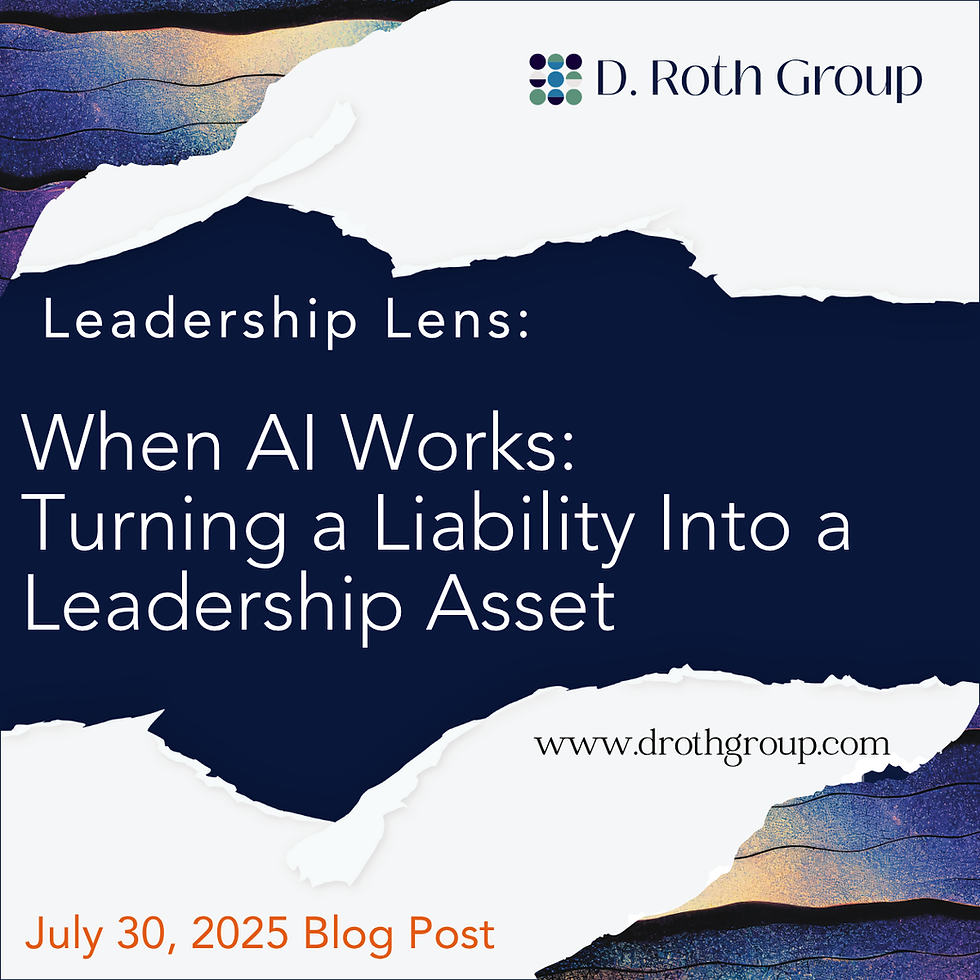When AI Works: Turning a Liability Into a Leadership Asset
- D. Roth Group

- Jul 29
- 3 min read
Updated: Aug 1

AI is here, and it’s moving faster than most of us expected. From instant insights to generated content, it’s changing how teams work, how leaders make decisions, and what organizations prioritize.
But amid the speed and scale, one critical truth keeps rising to the surface:
Tools don’t lead people. People lead people.
As AI becomes more embedded in workflows, it’s not the tech itself that determines success, it’s how leaders use it, with clarity, responsibility, and intention.
The Promise and the Pressure of AI
AI offers leaders a suite of capabilities: predictive modeling, automated reporting, faster content creation, even tone-of-voice calibration. But too often, it’s marketed as a silver bullet, a cure-all for bandwidth issues, performance gaps, or even leadership shortcomings.
The reality? AI doesn’t replace people, strategy, or judgment.
A Deloitte study found that 94% of business leaders are investing in AI tools, yet only 37% feel confident in how to ethically and effectively integrate them. That gap isn’t about the technology, t’s about the humans using it.
What AI Can’t Do (and Was Never Meant To)
AI is brilliant at providing answers, but not direction. It excels at synthesizing data, but lacks wisdom. And it can’t replicate the empathy, nuance, or values that true leadership requires.
Without human direction, AI can accelerate the wrong priorities, reinforce biases, or create unintentional disconnection between people and purpose. In the wrong hands, AI doesn’t just miss the mark, it magnifies the distance between good intentions and actual impact.
What Makes AI Work: It’s Not Mastery. It’s Collaboration.
This is where most people go wrong: they treat AI like a shortcut.
Drop in a prompt. Get a result. Move on.
But AI isn’t a quick fix for human limitations. It’s a collaborator for exploration, research, brainstorming, synthesis, and connection.
When AI works, it’s because people use it with intention. Here’s what effective leaders are doing:
Asking better questions, not just faster ones
Pairing AI with lived experience and contextual knowledge
Creating values-based boundaries for output
Fact-checking before publishing or implementing
Staying fully accountable for the final decisions
The goal isn’t automation, it’s augmentation.You don’t remove the human. You reinforce the human.
Where AI Can Help, Without Leading
If you're wondering how to bring AI into your workflow without compromising your values, here’s a solid starting point:
Clarify the Objective First Don’t start with a tool. Start with a question. What are we solving for? AI enhances direction, it doesn’t create it.
Use AI for Exploration, Not Delegation AI works best as a creative partner. Use it to surface blind spots, test angles, and accelerate ideation. But you still need to think.
Keep Ethics and Context in the Room AI doesn’t have judgment. You do. Define what’s off-limits, what’s sensitive, and what “good” looks like before you ask for output.
Refine Instead of Rushing AI is fast. That doesn’t mean you should be. Pause. Reflect. Adjust. Leaders who slow down to add nuance will consistently outperform those who just hit publish.
Maintain the Human Layer AI can’t build trust, lead a team, or communicate vision. That’s your job. Use AI to free up capacity, not to avoid the human work that leadership requires.
The research above is a synthesis of trends gathered by the D. Roth Group team, drawing on insights from sources including Deloitte, McKinsey, StrategyDriven, Medium, and LinkedIn. The CEO's perspective reflects over two decades of experience guiding businesses through transformation, growth, and recalibration.
CEO Insight
Let’s be real: AI is brilliant. But it’s also blunt.
It doesn’t read the room. It doesn’t ask the hard questions. It doesn’t care if your organization is aligned or just running fast in the wrong direction.
That’s your job.
The real value of AI doesn’t come from speed. It comes from how we choose to use it. And that’s why the edge in this era isn’t intelligence. It’s integrity.
If you’re looking for a magic fix, AI will disappoint you.If you’re looking for a thinking partner, one that can accelerate your insight and sharpen your strategy, then AI might just be one of the most powerful additions to your leadership toolkit.
At D. Roth Group, we don’t treat AI as a threat. We treat it as a strategic collaborator, one that still needs human guardrails, thoughtful intent, and strong leadership at the helm.
AI isn’t the threat. You are, if you lead without clarity. Sit with that for a minute.
And when you’re ready to grow your business and support your people without compromising your values or voice, call us.
D. Roth Group. We’ll be here.

Comments